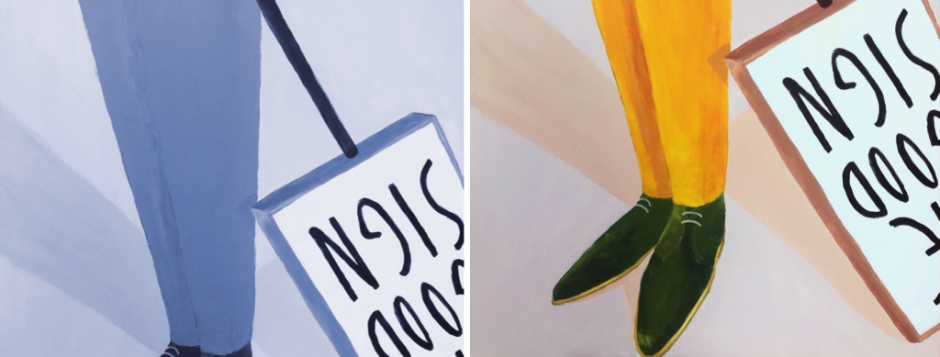Assess and/or give feedback for learning.
Course: MA Innovative Fashion Production, Year 2024/25
Introduction
Recently, two students were asking for a conversation to clarify upon the feedback and grade I had given them. They felt they had been treated unfairly as they didn’t receive the highest mark within their working group, even though they had done “all the work”. Whilst the others had done less. The unit Business Models and Fashion Production asks students to working in groups alongside individual tasks connected to the group work.
Evaluation
In a private conversation with both, I had the chance to explain to the students how their work is marked against the learning outcomes and assessment criteria based on specific examples from their own work. I think that both students only then properly understood the learning outcomes’ meaning and how to improve in the areas they fell short on, namely in process and knowledge. I found the conversation lead to a satisfying result on both sides and illustrated the student’s learning journey (see fig. 1) and the teacher’s (see fig. 2).

This experience illustrates three stages of student learning gain opportunities. The first, learning is happening by doing (Willcocks, 2018). However, it also highlights that doing alone does not capitalise on the full learning gain potential (fig.1. bar chart 1). Engagement with feedback (Gibbs, 2015; Brooks 2008) helps the learner to identify shortcomings and prompts further reflection and criticality. Lastly, feedback discussion (Brooks, 2008) encourages the student to question not only their work with a another person (Vygotsky, 1978), but an opportunity to question the teacher’s decisions and debate the work, furthering skills such as criticality, negotiation and autonomous learning.
Whist I matched the student’s learning journey against learning gain (fig.1), I decided to highlight the depth of understanding for the student’s learning needs on the teacher’s learning journey (fig.2). This is because of the following experience.
Subsequently, in the seminars on the new unit, I gave both students pointers to where and how they have a chance to work on the skills which they haven’t mastered yet. Catching myself doing it, I realised that I got to know the learning needs of these students much better than those of the students I haven’t talked about the feedback to. Through the feedback discussion, my memory was altered and alerted (fig.2).

Implications and action plan
Based on this experience, I agree with Brooks (2008), that It is not more feedback the students need, the value lies in providing fewer, but specific, meaningful examples (ie. Student’s own work) which should act as a point in case, applicable to further similar tasks.
Gibbs, 2015
“Changing what students do with your feedback can make more difference than changing your feedback.”
On my course, we currently don’t have feedback discussions planned into the curriculum. Therefore, I will advocate for a curriculum-embedded feedback discussion (Brooks, 2008). As a consequence, students would have to engage with their feedback in preparation (Gibbs, 2015, ch. 14), thus maximising on the learning for work already done benefitting both the learner and the teacher .
Finally, as Race (2005) points out, students need to be clear, that the feedback discussion and the resulting take-aways are serving them to do better on the next task, which is called feedforward. In the future, I will work out together with the student which skills they have acquired and how they are transferrable to future tasks.
In summary, clarity, specificity, practice, feedback and feedback discussion increases the student’s learning gain and the teacher’s understanding for student’s learning needs.
References
Brooks, K. (2008) AdvanceHE. Available at: chrome-extension://efaidnbmnnnibpcajpcglclefindmkaj/https://s3.eu-west-2.amazonaws.com/assets.creode.advancehe-document-manager/documents/hea/private/feature-kate-brooks_1568036673.pdf (Accessed: 15 March, 2025)
Fry, H. and Gibbs, G. (2015) A handbook for teaching and learning in higher education: enhancing academic practice. Fourth edition. Edited by S. Ketteridge and S. Marshall. Milton Park, Abingdon, Oxon: Routledge.
Race, P. (2013) ‘Making Learning Happen: A Guide for Post‐Compulsory Education. By Phil Race. Thousand Oaks, Calif.: Sage Publications, 2010. xi + 250 pages. ISBN 978‐1‐84920‐114‐8. $44.95.’, Teaching Theology & Religion, 16(1), pp. 102–104. Available at: https://doi.org/10.1111/teth.12018.
UAL Central Saint Martins (2018) Museum & Study Collection: Judy Willcocks Copenhagen Presentation. 27th June, (min. 10:23) Available at: https://www.youtube.com/watch?v=M3O7MM5WuFo (Accessed: 15 March, 2025)
Vygotsky, L.L.S. (1978) Mind in Society: The Development of Higher Psychological Processes. Cambridge, MA: Harvard University Press.


